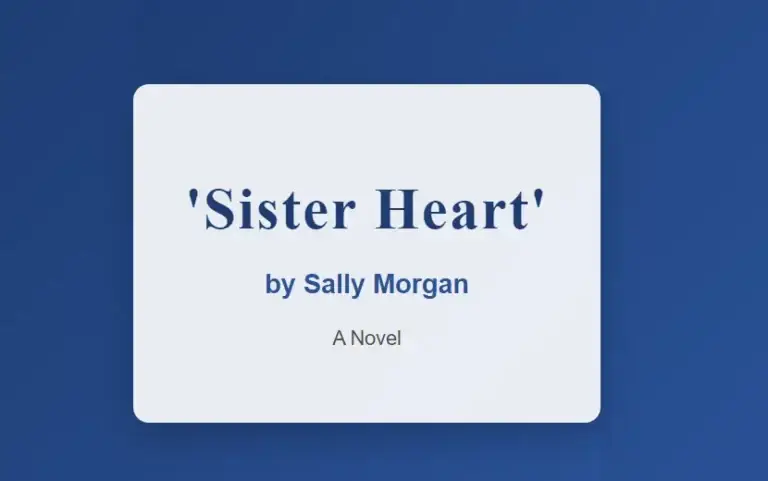Introduction
Sally Morgan, an acclaimed Indigenous Australian author and artist, has made significant contributions to Australian literature with her powerful narratives exploring Aboriginal identity and history. “Sister Heart,” published in 2015, is a moving verse novel that delves into one of the darkest chapters of Australian history: the Stolen Generations. Through sparse yet evocative free verse, Morgan tackles themes of cultural identity, familial bonds, and the lasting trauma of forced separation.
Table of Contents
This work stands as a testament to the resilience of Indigenous peoples and serves as a crucial tool for understanding and acknowledging the impact of past government policies on Aboriginal communities. “Sister Heart” is not only a significant addition to Morgan’s oeuvre but also an important piece of contemporary Australian literature that gives voice to those long silenced.
Brief Summary
“Sister Heart” follows the journey of an unnamed Aboriginal girl who is forcibly removed from her family and community in the north of Australia. Taken to a children’s home in the south, she grapples with the loss of her family, culture, and identity. The narrative unfolds through the girl’s perspective as she forms new friendships, particularly with a girl named Annie, and tries to maintain hope of returning home. Through fragments of memory and new experiences, the protagonist navigates the challenges of her new environment while holding onto her heritage and the dream of reuniting with her family.
The Power of Verse in Storytelling
Morgan’s choice to tell this story through verse is both stylistically striking and emotionally poignant. The sparse, fragmented nature of the poetry mirrors the protagonist’s fractured experiences and memories. Short lines and stanzas create a rhythm that pulls the reader through the narrative, evoking the girl’s racing thoughts and emotions.
“Words / float away / like clouds / I can’t catch”
This excerpt exemplifies how the verse format captures the protagonist’s struggle to express herself in a new environment where her native language is forbidden. The poetic structure also allows for moments of intense emotion to be distilled into powerful, concise images that resonate deeply with the reader.
Exploration of Identity and Loss
At its core, “Sister Heart” is an exploration of identity in the face of cultural erasure. The protagonist’s struggle to maintain her sense of self while being stripped of her family, language, and customs is heart-wrenching and vividly portrayed.
“My name / is a secret / I keep / under my tongue”
This powerful image encapsulates the girl’s determination to hold onto her identity despite the institution’s attempts to erase it. Morgan deftly illustrates how names, language, and cultural practices are intrinsically linked to one’s sense of self, and how their loss can be profoundly traumatic.
The Bond of Friendship
Amidst the bleakness of the children’s home, Morgan highlights the resilience of the human spirit through the friendship between the protagonist and Annie. This relationship becomes a lifeline for both girls, offering comfort and a sense of belonging in an otherwise alien environment.
“Annie’s smile / is a tiny sun / warming my face”

The metaphor of Annie’s smile as a sun beautifully captures the hope and warmth that their friendship brings to the protagonist’s life. Through this relationship, Morgan explores themes of solidarity, shared experience, and the formation of chosen families in the face of adversity.
Intergenerational Trauma and Healing
“Sister Heart” doesn’t shy away from depicting the long-lasting effects of the Stolen Generations policy. Morgan sensitively portrays how the trauma of forced separation reverberates through generations, affecting not only those directly impacted but also their descendants.
“Mum’s eyes / are dark pools / of sadness / I can’t swim in”
This vivid imagery illustrates the emotional distance between the protagonist and her mother, hinting at the unresolved trauma that continues to affect their relationship. By addressing these ongoing impacts, Morgan emphasizes the need for continued healing and reconciliation in Australian society.
Literary Techniques in “Sister Heart”
Morgan employs several literary techniques to enhance the emotional impact of “Sister Heart.” Imagery is used extensively throughout the novel to create vivid sensory experiences that immerse the reader in the protagonist’s world. Metaphors and similes, like the ones mentioned earlier, help to convey complex emotions in accessible ways.
Repetition is another key technique, with certain phrases or images recurring throughout the text to emphasize important themes or emotions. The use of white space on the page is also significant, with the gaps between stanzas often speaking as loudly as the words themselves, representing silences, unspoken thoughts, or the passage of time.
Lastly, Morgan’s use of an unnamed protagonist allows readers to connect more universally with the experience, while also highlighting how the Stolen Generations policy sought to erase individual identities.
Critical Reception and Impact
“Sister Heart” has been widely praised for its sensitive handling of a difficult subject matter and its accessibility to younger readers. Critics have lauded Morgan’s ability to convey complex historical and emotional themes through simple, powerful language. The book has been recognized with several awards, including the Prime Minister’s Literary Award for Children’s Fiction in 2016.
The novel has become an important educational tool, used in schools across Australia to teach about the Stolen Generations and promote understanding of Indigenous experiences. Its impact extends beyond the classroom, contributing to broader conversations about reconciliation and the ongoing effects of historical policies on Indigenous communities.
Conclusion
“Sister Heart” stands as a powerful testament to the resilience of the human spirit and the enduring strength of cultural identity. Through her masterful use of verse, Sally Morgan has created a work that is both deeply personal and universally resonant. The novel not only sheds light on a dark chapter of Australian history but also emphasizes the ongoing need for acknowledgment, healing, and reconciliation. By giving voice to those who were silenced, “Sister Heart” ensures that the stories of the Stolen Generations continue to be heard, understood, and remembered. It serves as a poignant reminder of the power of literature to educate, empathize, and ultimately, to heal.



2 Comments
Pingback: 'Sold' by Patricia McCormick: Comprehensive Summary and Analysis - LitGram by MukeshRishit
Pingback: N. Scott Momaday's "House Made of Dawn": A Comprehensive Analysis - LitGram by MukeshRishit